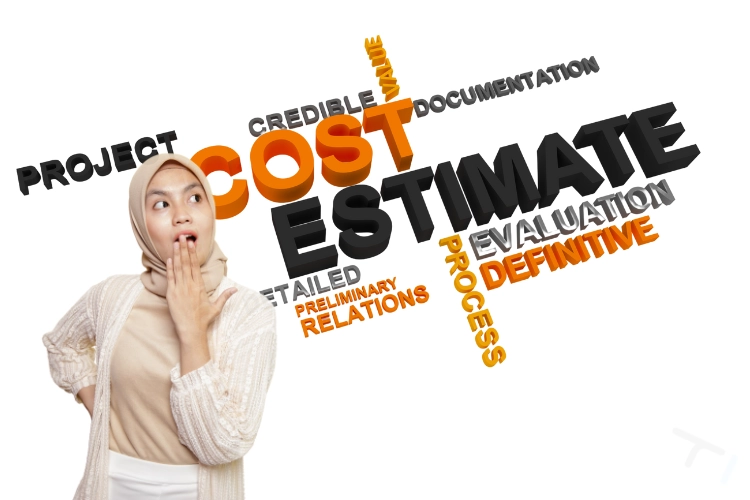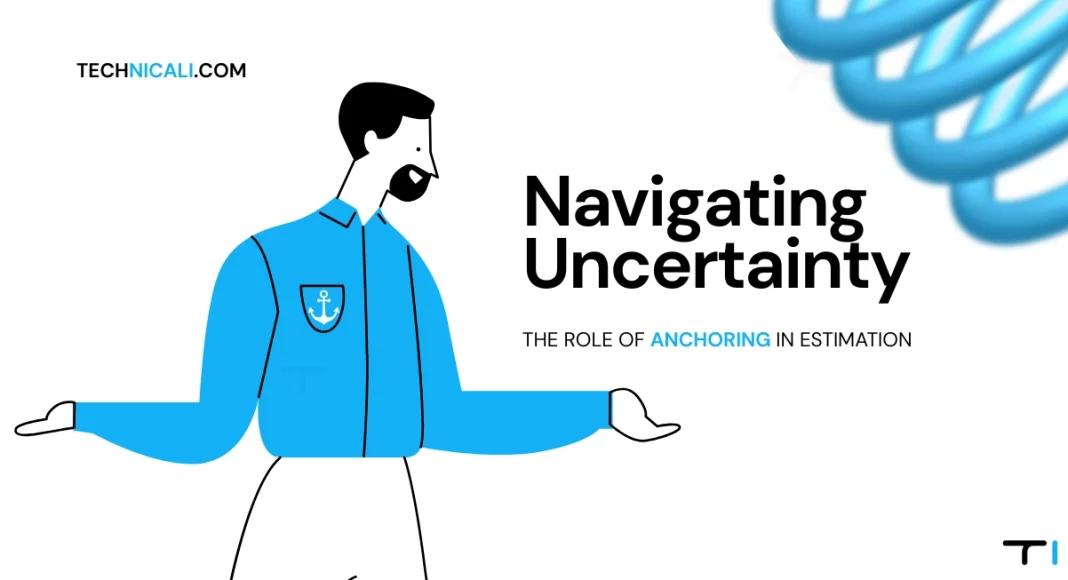Hey there, have you ever been in a situation where you had to make an important decision, but you just didn’t have enough information to go on? Maybe you were trying to decide how much to bid on a project or how much to charge for your services, and you just had no idea where to start. Sound familiar?
Well, people like you and me are not alone. In fact, it turns out that our brains have a natural tendency to rely on shortcuts and mental shortcuts, known as “anchoring,” to help us navigate uncertainty and make decisions when we don’t have all the facts.
But as you’ll see, anchoring can also lead us astray and cause us to make some seriously questionable choices. So, how can we use the power of anchoring to our advantage while still being mindful of its limitations? That’s what we’ll be discussing in this post on navigating uncertainty in project costing.
Get ready to learn how to use anchoring to your advantage and avoid falling into its pitfalls. So, let’s dive in!
Contents
Introduction to System Thinking
Let’s first take a look at the concept of System-1 and System-2 Thinking.

System-1 is the fast, automatic, and intuitive thought process we use to quickly make decisions and judgments. It’s the part of our brain that helps us survive in times of danger, such as when we see a lion and immediately run away without thinking about it.
System-2 is the slow, more rational, and logical thought process we use to make more complex decisions and solve problems.
While System1 and System2 have their benefits, the problem arises when we use System1 instead of System2, when System2 would be the appropriate system.
This can lead us to make biases and fallacies that are not optimal.
Now, let’s consider the concept of anchoring. Anchoring refers to the phenomenon where our initial estimate or starting point for something affects our subsequent estimates or judgments.
For example, consider the following two questions:
- Is the height of the tallest redwood more or less than 1300 feet?
- What is your best guess about the height of the tallest redwood?
If you were asked these questions, your initial estimate (the “anchor”) of 1300 feet would likely affect your subsequent estimation of the height of the tallest redwood. Research has shown that the initial anchor often significantly influences people’s estimates.
Anchoring uses the System-1 thinking process, which makes it especially risky when making decisions or estimates that require System-2 thinking. It is essential to be aware of anchoring and its potential effects on our decision-making to make more accurate project cost estimates.
Let’s define anchoring.
It’s basically when we allow one piece of information to heavily influence our decision-making, even if that information is totally unrelated to the task.
Confused? Let me give you an example.
Imagine that you and a friend are betting on the outcome of a coin flip. Your friend goes first and says, “Heads!” Being uncertain about the result, you say, “Tails!”
What just happened is that your friend set an “anchor” by saying, “Heads!” and you allowed that to heavily influence your decision. Even though the outcome of a coin flip is totally random, you let this one piece of information (“Heads!”) affect your decision.
Another Example? Let’s say you’re trying to decide how much to charge for a project. You have no idea where to start, so you look at the prices charged by your competition.
Even though the prices they charge may not reflect what would be fair or profitable for you, they become an anchor you use to set your own price. This could lead to you establishing a price that is either too low or too high.
Anchoring can also be seen in how an initial offer affects our negotiation tactics and strategies. Research has shown that people tend to accept or reject bids based on their initial anchor rather than considering all available options.
I think that’s enough examples of anchoring in action to make you realize the importance of avoiding anchoring when making decisions.
The Importance of Accurate Cost Estimation in Project Management
Now, you might be thinking, “Who cares? It’s just a silly guessing game.” But anchoring can have severe consequences in the world of project management.

Suppose you’re attempting to calculate the expense of a new project. If your employer decides on an arbitrary number as the foundation, you may be tethered to it, even when it is far from accurate.
This can lead to inaccurate cost estimates and costly overruns.
So, what can we do to avoid anchoring in project costing?
One option is gathering as much information as possible before deciding. This can help us avoid being swayed by irrelevant data. It’s also a good idea to get a second(or third, or fourth) opinion on estimates to ensure we’re not being influenced by one biased perspective.
Anchoring can be a sneaky lucifer that messes with our ability to accurately estimate project costs. But by being aware of its challenges and taking steps to mitigate its influence, we can make more informed decisions and keep our projects on track.

Estimating the cost of a project is one of the most critical and challenging tasks for any project manager. It requires balancing business needs and financial constraints and dealing with uncertain factors such as changing regulations, fluctuating markets, and unexpected surprises.
It’s like trying to predict the weather on a day when you have a barbecue planned. You can make all the preparations, but if it starts raining, all your hard work goes down the drain (literally).
Anchoring Bias
Here we rely on initial information to make decisions rather than objectively evaluating all options. For example, Imagine you’re estimating the cost of a project, and your boss tells you that it should cost no more than $50,000. Suddenly, all your cost estimates are anchored to that number, even if it’s unrealistic.
Overconfidence
Thinking we know more than we do leads to overestimating our abilities and knowledge. We might think we can complete the project in a shorter time than we can, resulting in inaccurate cost estimates.
Availability Heuristic
When basing our estimation on information that is readily available to us rather than considering all relevant factors. For example, relying on the price of a similar project completed in the past to estimate this one without considering current market conditions or any other factors that might have changed.
Optimism Bias
Believing that everything will work in our favor. We often think that things will go smoothly, and we don’t consider all the potential problems or delays that could arise, leading to an underestimation of costs. It’s easy to get caught up in the excitement of a project and forget to consider all possible scenarios.
Groupthink or Uncertainty Avoidance
The pressures to conform to the group’s opinion lead to flawed decision-making. We might be reluctant to voice our concerns or suggest more accurate cost estimates if it conflicts with the rest of the group’s opinion.
Escalation of Commitment
We continue to invest resources in a project even when it is not going well, due to sunk cost fallacy. We feel that we have already put so much into it that we can’t give up. It leads to costly overinvestment in projects that might have been more cost-effectively scrapped.
Limited Knowledge and Expertise
Not having the necessary knowledge and expertise to accurately estimate costs. This is especially true in complex projects(like, software development), where a lack of understanding of the various components(QA, Coding, Backend, Frontend, Support, Marketing) can lead to inaccurate estimates.
Changing Project Requirements
This is a common problem in estimation for all kinds of client projects. Like software development, where the client’s requirements keep changing, it is difficult to accurately assess how much time and money will be needed. Having to reevaluate and adjust cost estimates due to changes in project scope can cause delays and budget overruns.
These factors can lead to inaccurate cost estimation and cause significant problems with project budgeting.
Applying Anchoring to Project Cost Estimation: Strategies to Implement it.

So, how do we set anchor points in project cost estimation?
Do not worry, my beloved Project Managers; we have a few strategies that can help to make accurate cost estimates:
- Identify Relevant Reference Points: When estimating project costs, it’s essential to consider all pertinent reference points that may influence your estimate. This could include market prices for similar products or services, industry standards, or historical data from past projects.
- Use Multiple Reference Points: To reduce the influence of any single reference point, consider using numerous reference points to anchor your cost estimate. This could include considering a range of prices from different sources or considering both high and low estimates.
- Consider Expert Judgment: When estimating costs, consider seeking expert review from individuals with relevant experience or knowledge. Their insights can help anchor your cost estimate and reduce the risk of relying on incomplete or outdated information.
- Use Benchmarks: Benchmarks are standards or measurements that can compare your cost estimate to others in the industry. Using benchmarks, you can anchor your assessment to a more objective reference point and reduce the risk of over or under-estimating.
- Use Reverse Anchoring: Rather than starting with a reference point and adjusting your estimate from there, try starting with a rough estimate and using reference points to refine and improve it. This can reduce the influence of any initial anchors and enhance the accuracy of your assessment.
- Adjust for Inflation: If your cost estimate is based on historical data or prices from the past, be sure to adjust for inflation to ensure that your estimate is accurate in current dollars.
- Consider Sunk Costs: Sunk costs are costs that have already been incurred and cannot be recovered. It’s essential to consider sunk costs when estimating project costs, as they can influence your decision-making and anchor your estimate.
- Utilize Cost Modeling Techniques: Techniques such as cost-benefit analysis and parametric estimation can provide more accurate cost estimates by considering a range of possible scenarios.
- Use a Decision Tree: A decision tree can be used to visually represent a decision’s potential outcomes, including each option’s costs and benefits. A decision tree can help anchor your cost estimate to the possible outcomes of different choices and reduce the risk of over or under-estimating.
- Use Sensitivity Analysis: Sensitivity analysis is a tool that can be used to evaluate how sensitive your cost estimate is to changes in certain variables. By running a sensitivity analysis, you can adjust your estimate to account for potential changes and provide more accurate cost estimates.
With this, you can apply anchoring when presenting the cost estimate to the client and conduct deep analysis to ensure the cost estimate is accurate and reliable.
For what? To help ensure successful projects and profits will make both the client and you happy. Win-Win!
Overcoming the Limitations of Anchoring in Project Cost Estimation
Okay! Now, let’s talk about overcoming the pesky problem of anchoring in project cost estimation. As we learned, anchoring is when our estimates or judgments are influenced by an initial piece of information, even if it’s completely irrelevant. This can be a real pain in the butt when it comes to project costing, as it can lead to unrealistic expectations or even costly mistakes.

Fortunately, there are ways to minimize the impact of anchoring on your cost estimation process.
- Be aware of your Biases: The first step to overcoming anchoring is recognizing that it exists and can influence your estimates. By acknowledging this, you can be more mindful of the potential for anchoring to skew your calculations.
- Verify and Validate Estimates: One way to reduce the influence of anchoring is to gather estimates from multiple sources. This can help you get a more balanced perspective and avoid being anchored to any one particular estimate. So, Always Double-check and Verify your assumptions and ensure they are accurate by validating them with reliable data.
- Use Estimation tools and techniques: Some various tools and techniques help you make more accurate estimates, such as analogies, triple constraints, and expert judgment. Using these tools and techniques, you can reduce the influence of anchoring on your estimates.
- Adopt a Range-based Approach: Don’t rely on a single estimate; instead, create a range of possible estimates by considering the best case, worst case, and most likely scenarios. This will help you avoid the pitfalls of anchoring while still providing the client with an accurate estimate.
- Take a Deep Breath + Breaks: Sometimes, taking a break from an estimation task can help you clear any mental block, and you may come back to it with a fresh perspective, which can help reduce the influence of anchoring on your estimates.
Conclusion
In conclusion, anchoring can be a powerful influence on our decision-making, especially regarding project cost estimation. It’s essential to be aware of this bias and try to overcome it by considering a range of estimates and seeking input from various sources. But let’s not forget the value of our trusty old friend, System-1. Without it, we might not have survived this long as a species (granted, we might not have experienced as much heartache either). It’s all about finding the right balance between fast, intuitive, and slow, logical thinking.
So next time you’re faced with a project costing conundrum, don’t be afraid to use your gut, just be sure to double-check with some good ol’ fashioned reasoning too.
If you are looking for project management tools to guide you through the project cost estimation process, then we highly recommend our top 7 picks.
Whether a freelancer, small business owner, or enterprise, the below free tools can help you make more accurate estimates and achieve better project outcomes.



